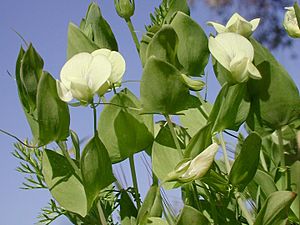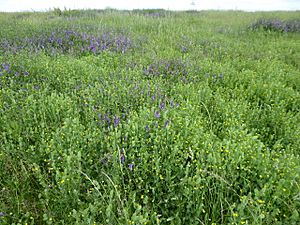Lathyrus aphaca facts for kids
Quick facts for kids Lathyrus aphaca |
|
|---|---|
 |
|
| Scientific classification | |
| Synonyms | |
|
The Lathyrus aphaca, often called the yellow pea or yellow vetchling, is a type of plant that lives for one year. It belongs to the Fabaceae family, which includes peas and beans. This plant has yellow flowers and fruits that look like small peas.
It first grew in the Middle East. From there, it spread across Europe and other parts of the world. You can often find it growing as a weed in farm fields and along roads. In some parts of South Asia, people eat its fruits to add to their meals. However, eating too many can make you sick and is not recommended.
What the Yellow Pea Looks Like
The yellow pea plant, Lathyrus aphaca, is an annual species. This means it completes its whole life cycle in one year. It is part of the Fabaceae family, also known as the legume family. These plants can grow up to about 100 centimeters (about 3 feet) tall.
The plant is usually pale green and smooth, without any hairs. Its stems have angles but no wings. What look like leaves are actually special parts called stipules. These stipules are shaped like an arrow or spearhead and can be up to 50 millimeters long. The true leaves are very small and look like simple tendrils.
The flowers are usually yellow and often have violet streaks. They are about 10–13 millimeters long. Each flower grows on a long stalk, up to 50 millimeters, from where the leaves meet the stem. These flowers have both male and female parts (they are bisexual). They have 10 stamens (male parts) and 1 style (female part). The yellow pea plant has 14 chromosomes in its cells.
Where the Yellow Pea Grows
Scientists believe the yellow pea first appeared in the Middle East, especially around Syria and Jordan. This area is known for many different types of legume plants. Edible peas were first grown in a region called the Fertile Crescent. Weeds like Lathyrus aphaca likely started growing in disturbed areas, like early farms, between 23,000 and 11,000 years ago.
The yellow pea can actually be helpful in farm fields. It can perform nitrogen fixation. This means it takes nitrogen from the air and puts it into the soil, which acts like a natural fertilizer. Also, if a small amount of it gets mixed with harvested grains, it can be eaten safely.
The natural home of Lathyrus aphaca is probably dry, rocky areas in the Middle East. These places are sometimes called phrygana or garrigue. In these countries, you can find the plant both in the wild and in farmed areas. It can be a strong weed, mostly in wheat fields, but also in other crops like sugarcane in Pakistan.
Over the last 10,000 years, as farming spread, the yellow pea also spread. It reached southern Asia, as far as Bangladesh, and southern Europe, including Portugal and even the Azores. In these places, people often think it's a native plant. However, it's more likely that it was brought there a long time ago by humans. These plants are called archaeophytes. They found similar dry, rocky habitats where they could continue to grow wild.
In northern Europe, the yellow pea hasn't found many natural wild places to grow. In Poland, for example, it grows in different spots like forest edges, dry lawns, and along roads, especially railway lines. It also grows in orchards, farm fields, and empty lands.
Since the early 1900s, the yellow pea has become less common in Europe. This is because new ways of cleaning seeds have removed it from grain crops. In the Netherlands, its numbers have dropped a lot since 1950. Germany and Poland have seen similar declines. However, it has spread to other parts of the world as a farm weed, including the United States, South Africa, and Australia.
Yellow Pea in the United Kingdom
In Britain, the yellow pea has been recorded since 1632. It was first found near Gravesend by Thomas Johnson. Because it was found so early, it could be either a native plant or an archaeophyte (a plant introduced a very long time ago). It is not considered a neophyte, which is a plant introduced more recently.
It's hard to say for sure if it's native or introduced. If it grows in wild, natural areas, it might be native. If it grows mostly in farm fields, it's probably an archaeophyte. Growing along roadsides makes it even harder to tell. Many roadside weeds are considered native in Britain, even though roads are a clear way for plants to be introduced.
Despite this uncertainty, the yellow pea is usually considered a native plant in Britain. It is listed as VU (Vulnerable) on the Red List. This means it is at risk of disappearing.
In 2021, Natural England named Swanscombe Peninsula in Kent a Site of Special Scientific Interest. This was partly because of the important population of yellow vetchling growing there.


